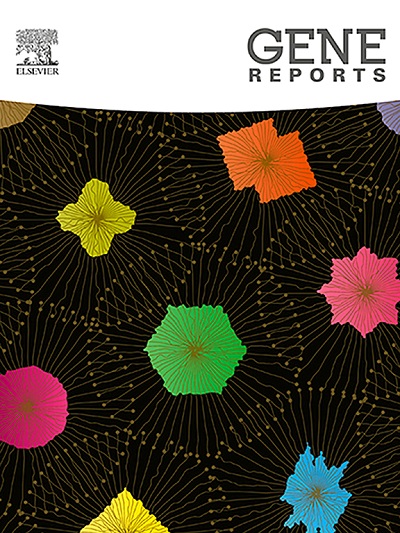牙周炎患者的 CC 趋化因子受体 5 和 CC 趋化因子配体 5 基因多态性--一项病例对照研究
IF 1
Q4 GENETICS & HEREDITY
引用次数: 0
摘要
目的 本研究旨在评估CC趋化因子受体5(CCR5)G59029A和CC趋化因子配体5(CCL5)-28 C/G基因多态性在牙周炎患者和非牙周炎患者中的相关性:第一组(牙周健康,n = 86)和第二组(全身慢性牙周炎,n = 86)。记录牙周临床参数,如牙周探诊深度(PPD)、临床附着丧失(CAL)、菌斑指数(PI)和出血指数(BI)。采用等位基因特异性聚合酶链反应(AS-PCR)鉴定 CCL5 和 CCR5 基因的多态性位点。结果 在测试组中,CCL5 基因多态性的杂合基因型 CG 和等位基因 G 更为普遍(P 值 = 0.001,0.01)。结论研究发现,CCL5 和 CCR5 基因多态性与牙周炎之间存在显著关联。本文章由计算机程序翻译,如有差异,请以英文原文为准。
CC chemokine receptor 5 and CC chemokine ligand 5 gene polymorphisms in patients with periodontitis - A case–control study
Aim
This study aimed to evaluate the association of CC Chemokine Receptor 5 (CCR5) G59029A and CC Chemokine Ligand 5 (CCL5) -28 C/G gene polymorphisms in patients with and without periodontitis.
Materials and methods
A total of 172 individuals were enrolled, divided into two groups: Group I (periodontally healthy, n = 86) and Group II (generalized chronic periodontitis, n = 86). Periodontal clinical parameters such as Periodontal Probing Depth (PPD), Clinical Attachment Loss (CAL), Plaque Index (PI), and Bleeding Index (BI) were recorded. Allele-specific PCR (AS-PCR) was used to identify polymorphic sites in the CCL5 and CCR5 genes.
Results
The heterozygous genotype CG and allele G was more prevalent in the Test group (p value = 0.001, 0.01) for CCL5 gene polymorphism. Similarly, the heterozygous genotype AG and allele G for CCR5 gene polymorphism was significantly higher in the Test group (p value = 0.002, 0.04).
Conclusion
The study found a significant association between CCL5 and CCR5 gene polymorphisms and periodontitis.
求助全文
通过发布文献求助,成功后即可免费获取论文全文。
去求助
来源期刊

Gene Reports
Biochemistry, Genetics and Molecular Biology-Genetics
CiteScore
3.30
自引率
7.70%
发文量
246
审稿时长
49 days
期刊介绍:
Gene Reports publishes papers that focus on the regulation, expression, function and evolution of genes in all biological contexts, including all prokaryotic and eukaryotic organisms, as well as viruses. Gene Reports strives to be a very diverse journal and topics in all fields will be considered for publication. Although not limited to the following, some general topics include: DNA Organization, Replication & Evolution -Focus on genomic DNA (chromosomal organization, comparative genomics, DNA replication, DNA repair, mobile DNA, mitochondrial DNA, chloroplast DNA). Expression & Function - Focus on functional RNAs (microRNAs, tRNAs, rRNAs, mRNA splicing, alternative polyadenylation) Regulation - Focus on processes that mediate gene-read out (epigenetics, chromatin, histone code, transcription, translation, protein degradation). Cell Signaling - Focus on mechanisms that control information flow into the nucleus to control gene expression (kinase and phosphatase pathways controlled by extra-cellular ligands, Wnt, Notch, TGFbeta/BMPs, FGFs, IGFs etc.) Profiling of gene expression and genetic variation - Focus on high throughput approaches (e.g., DeepSeq, ChIP-Seq, Affymetrix microarrays, proteomics) that define gene regulatory circuitry, molecular pathways and protein/protein networks. Genetics - Focus on development in model organisms (e.g., mouse, frog, fruit fly, worm), human genetic variation, population genetics, as well as agricultural and veterinary genetics. Molecular Pathology & Regenerative Medicine - Focus on the deregulation of molecular processes in human diseases and mechanisms supporting regeneration of tissues through pluripotent or multipotent stem cells.
 求助内容:
求助内容: 应助结果提醒方式:
应助结果提醒方式:


